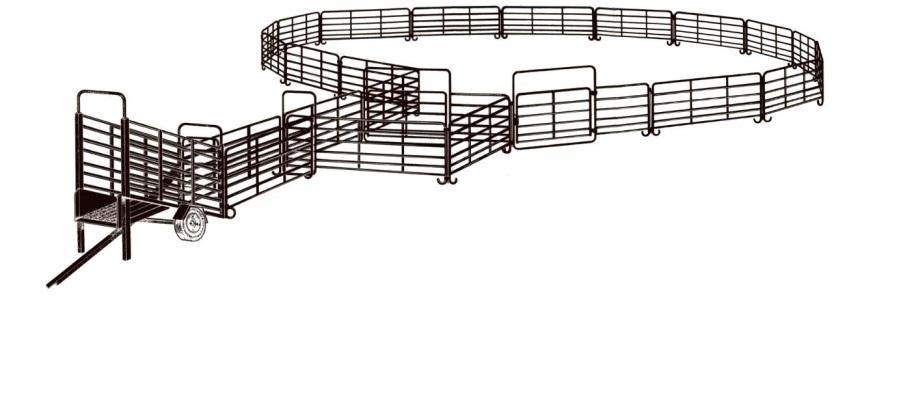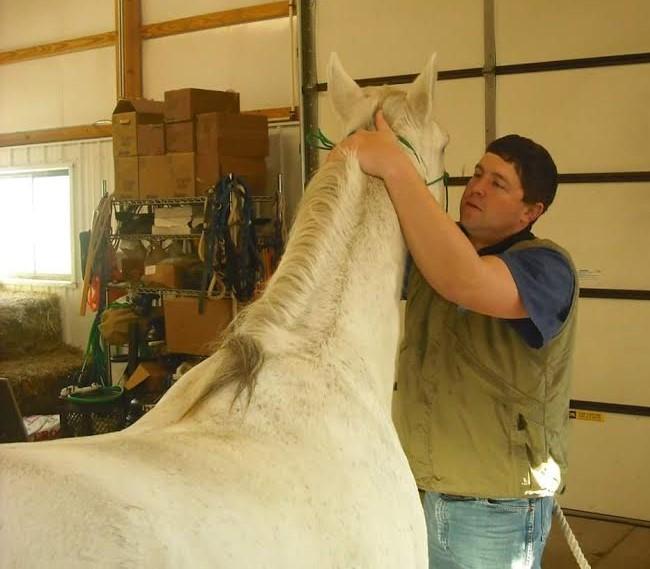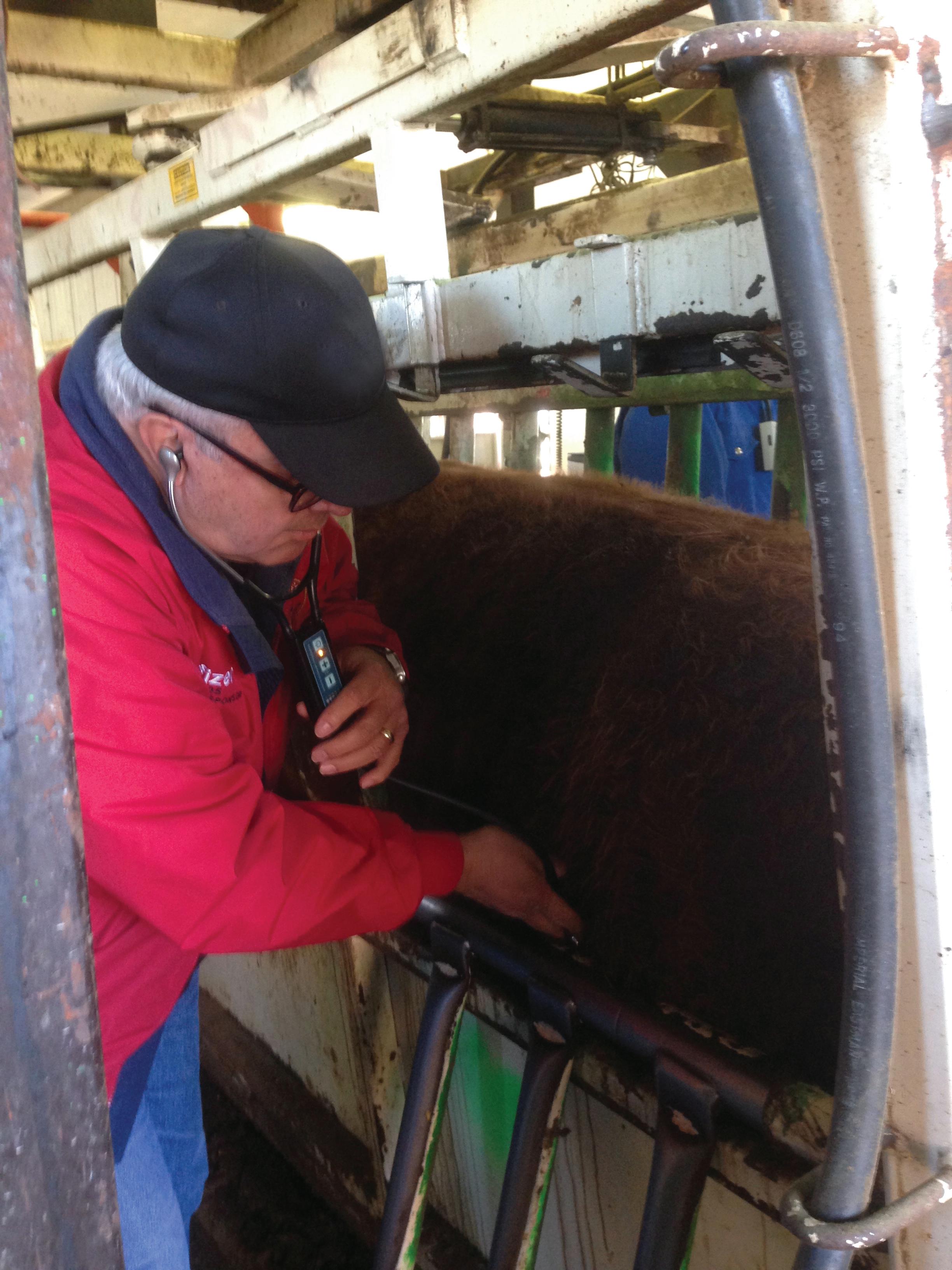
7 minute read
Speaking for the Horses: A Pain in the Neck
By: Dr. Matt Fehr, Animal Medical Center, Great Bend, KS
By: Dr. Matt Fehr, Animal Medical Center, Great Bend, KS
It’s chiropractic month at Animal Medical Center, so I thought I would talk a bit about what chiropractic care can do for your horses. Many of you have your horses adjusted fairly regularly and I applaud you and will hopefully give you a little more insight on what we are accomplishing with those adjustments. Those of you who have never had your horse adjusted, maybe I can give you enough information to stimulate you to try it out.
It’s chiropractic month at Animal Medical Center, so I thought I would talk a bit about what chiropractic care can do for your horses. Many of you have your horses adjusted fairly regularly and I applaud you and will hopefully give you a little more insight on what we are accomplishing with those adjustments. Those of you who have never had your horse adjusted, maybe I can give you enough information to stimulate you to try it out.
The first question I always get is, “how do you know if your horse needs an adjustment?” There is a very long list of signs that could hint at a horse needing an adjustment. They include, but are not limited to, lameness, soreness of the back, neck or virtually any other area, holding tail or head strangely, refusal to go into a lead on one side, bucking out of the blue, bucking in transition, refusal to bend, sore when cinched, etc.
The first question I always get is, “how do you know if your horse needs an adjustment?” There is a very long list of signs that could hint at a horse needing an adjustment. They include, but are not limited to, lameness, soreness of the back, neck or virtually any other area, holding tail or head strangely, refusal to go into a lead on one side, bucking out of the blue, bucking in transition, refusal to bend, sore when cinched, etc.
What does it mean for a horse to be “out”? Chiropractors hate to use “out” when talking about chiropractic care. Saying a bone is out indicates a bone being out of place, which is really not the case.
What does it mean for a horse to be “out”? Chiropractors hate to use “out” when talking about chiropractic care. Saying a bone is out indicates a bone being out of place, which is really not the case.
The bones do not technically get out of place, they actually just get stuck such that the joint does not move freely as it should. We call this “stuckage” a subluxation. A joint being subluxated causes a decrease in flexibility, causes tension in the muscles and tendons around the joint, and causes inflammation of those tissues as well as the nerves involved in the area. This all causes pain and stiffness that worsens with time.
The bones do not technically get out of place, they actually just get stuck such that the joint does not move freely as it should. We call this “stuckage” a subluxation. A joint being subluxated causes a decrease in flexibility, causes tension in the muscles and tendons around the joint, and causes inflammation of those tissues as well as the nerves involved in the area. This all causes pain and stiffness that worsens with time.
If the subluxated joint is left uncorrected for an extended time, the surrounding tissues can fibrose and in a sense “lock” the joint into that position. This is why many of these issues require multiple adjustments, over a period of weeks, in order to get them to stay in their normal position.
If the subluxated joint is left uncorrected for an extended time, the surrounding tissues can fibrose and in a sense “lock” the joint into that position. This is why many of these issues require multiple adjustments, over a period of weeks, in order to get them to stay in their normal position.
A common misconception is that chiropractic adjustments are all about the skeleton. Truth is, our adjustments are actually more about the nervous system than the skeleton. Everything in the body, from muscles to intestines, is controlled by the nervous system.
A common misconception is that chiropractic adjustments are all about the skeleton. Truth is, our adjustments are actually more about the nervous system than the skeleton. Everything in the body, from muscles to intestines, is controlled by the nervous system.
Daniels Manufacturing Co.
Daniels Manufacturing Co.
Quite frankly, I would say any horse that has either never been adjusted or that has not been adjusted in recent history, would benefit from an adjustment, especially horses that are worked or ridden hard. But, they do not have to even be in use to be in need. A horse’s day-to-day life is full of what we call micro-trauma. Just walking and standing on hard surfaces, putting a thousand pounds on the small surface of their feet is enough to cause issues.
Quite frankly, I would say any horse that has either never been adjusted or that has not been adjusted in recent history, would benefit from an adjustment, especially horses that are worked or ridden hard. But, they do not have to even be in use to be in need. A horse’s day-to-day life is full of what we call micro-trauma. Just walking and standing on hard surfaces, putting a thousand pounds on the small surface of their feet is enough to cause issues.
The World’s Leading Manufacturer of Cattle Handling Equipment
The World’s Leading Manufacturer of Cattle Handling Equipment
Double Alleyways
• Double Alleyways o Stationary & Portable – Fast, Easy and Safe way to process cattle o Stationary & Portable – Fast, Easy and Safe way to process cattle
All Hydraulic Squeeze Chute
• All Hydraulic Squeeze Chute o Stationary & Portable o Stationary & Portable o Quietest and most user friendly chute on the market featuring our unique squeeze design and neck stretcher o Quietest and most user friendly chute on the market featuring our unique squeeze design and neck stretcher
Complete Corral Units, Panels, Gates, Continuous Fence
• Complete Corral Units, Panels, Gates, Continuous Fence o Manufactured from the finest high tensile strength tubing
Continued on the next page
Continued on the next page
Daniels Manufacturing Co.
The World’s Leading Manufacturer of Cattle Handling Equipment
1/4 o Manufactured from the finest high tensile strength tubing
Facility Drawings and Consultations
• Facility Drawings and Consultations
Daniels Manufacturing Co.
o Low stress cattle handling that encourages voluntary cattle flow and animal well being
• Double Alleyways o Stationary & Portable – Fast, Easy and Safe way to process cattle
• All Hydraulic Squeeze Chute o Stationary & Portable o Quietest and most user friendly chute on the market featuring our unique squeeze design and neck stretcher o Low stress cattle handling that encourages voluntary cattle flow and animal well being
The World’s Leading Manufacturer of Cattle Handling Equipment


• Double Alleyways
• Complete Corral Units, Panels, Gates, Continuous Fence o Manufactured from the finest high tensile strength tubing
• Facility Drawings and Consultations o Stationary & Portable – Fast, Easy and Safe way to process cattle
• All Hydraulic Squeeze Chute o Stationary & Portable o Quietest and most user friendly chute on the market featuring our unique squeeze design and neck stretcher
• Complete Corral Units, Panels, Gates, Continuous Fence o Manufactured from the finest high tensile strength tubing
• Facility Drawings and Consultations o Low stress cattle handling that encourages voluntary cattle flow and animal well being
The central nervous system is contained in the skull and spine and it sends signals throughout the body through nerves that exit between the vertebrae the entire length of the spine.
When we have subluxations of these vertebrae and thus the inflammation we talked about above, we cause impingement of those nerves which in turn affects the organ(s) those nerves control.
If it is part of the intestine, then this could cause a change in gut motility and cause the horse to colic. If the nerve is controlling the muscles of the leg, it may cause the horse to misstep and trip or even fall.
Take for example, a horse that is jumping over an obstacle. This horse is expected to propel its thousand pound body, along with saddle and rider, into the air above the obstacle and then land safely on its feet on the other side. This takes very coordinated contraction and release of thousands of muscle fibers to perform correctly. If that horse has impinged nerves that are not firing efficiently and on time, he could potentially collapse in catastrophe on the other side of the obstacle.
If it is part of the intestine, then this could cause a change in gut motility and cause the horse to colic. If the nerve is controlling the muscles of the leg, it may cause the horse to misstep and trip or even fall.
Take for example, a horse that is jumping over an obstacle. This horse is expected to propel its thousand pound body, along with saddle and rider, into the air above the obstacle and then land safely on its feet on the other side. This takes very coordinated contraction and release of thousands of muscle fibers to perform correctly. If that horse has impinged nerves that are not firing efficiently and on time, he could potentially collapse in catastrophe on the other side of the obstacle.
So what does this all mean for you? Well, if you have a horse that you feel has become painful and is not working to its full potential, it most definitely could benefit from
So what does this all mean for you? Well, if you have a horse that you feel has become painful and is not working to its full potential, it most definitely could benefit from an adjustment. But more than that, if you have your horse adjusted on a regular basis, they will have fewer injuries, they will be more efficient with their feed and they will in general feel better and perform better. an adjustment. But more than that, if you have your horse adjusted on a regular basis, they will have fewer injuries, they will be more efficient with their feed and they will in

It’s kind of like your truck, you change the oil and rotate the tires regularly to keep it performing correctly. Shouldn’t your horse have regular maintenance to keep it performing too? **
It’s kind of like your truck, you change the oil and rotate the tires regularly to keep it performing correctly. Shouldn’t your horse have regular maintenance to keep it









